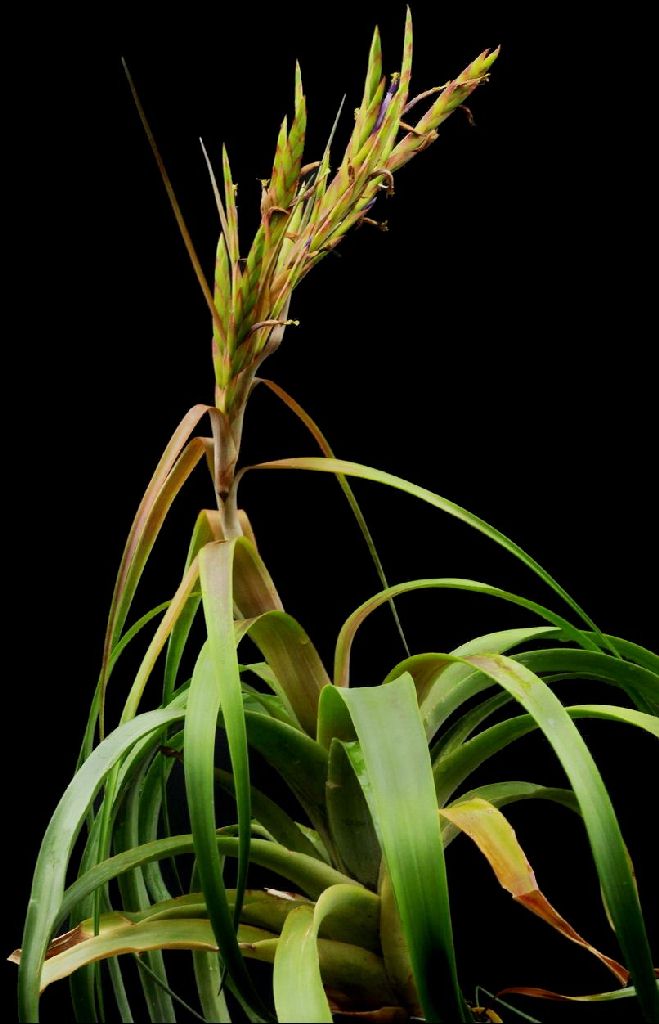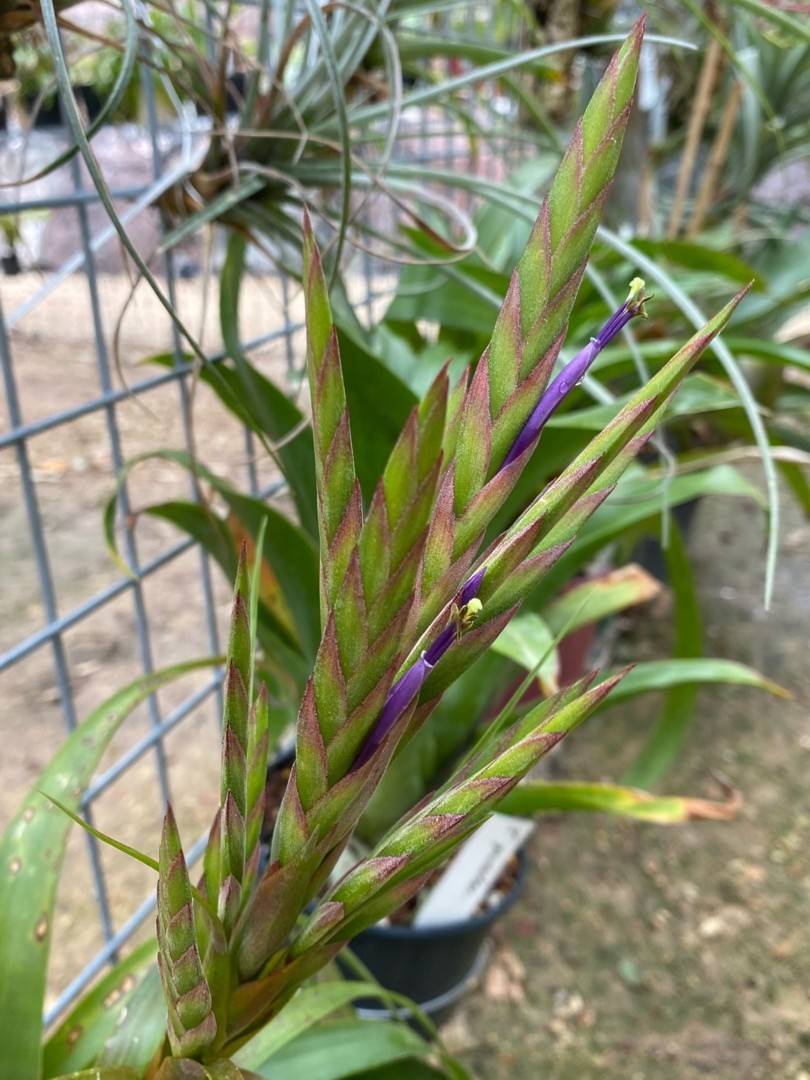




Plant stemless, flowering to 40cm high, leaves fairly numerous, (about 12) forming an erect, to recurved rosette, leaves to 40cm long, strongly nerved, green, but wine red when in sunny positions, the upper side with very fine and the underside with stronger fine white appressed scales.
Leaf Sheath broad oval, distinct from blade, to 10 cm long, to 7cm wide, same colour as blade, the edges bent,
Leaf Blade triangular, 2-3 cm wide next to sheath, the lower leaves broadly acuminate, and becoming short, the upper ones to 25cm long, and narrow acuminate, the edges bent, bending towards the outside or reflexed.
Scape erect, to 12 cm long, 5-7 mm diam. round, smooth, exceeding the leaves.
Scape Bracts extensively cover the scape, internodes 2-3 cm, similar to the leaves, sheath to 9cm long, 2-3 cm wide, brick red, erect, densely adjacent to the stem, with to 25cm long, narrow triangular blade, the outer bent back or reflexed, a distinct brown red colour.
Inflorescence bipinnate, to 20 cm long, 10cm wide, with 7-14 erect or slightly spreading compound spikes.
Primary bracts similar to the scape bracts, the sheath of the lower spikes 1/3 to 1/2 as long as the spike, however with the narrow triangular apiculate blade it much exceeds, the upper ones however are hardly as long as the sterile portion of the spike and are short tipped.
Spike to 10cm long, to 1.2 cm wide, lance like, acuminate, the whole smoothly complanate, with 7-11 sessile, densely distichously arranged (rhachis not visible at anthesis), not scented, to 5cm long flowers, extra to the 5 sterile bracts there is a 3cm long stem to the compound spike.
Flower bracts 2.3-2.9 cm long, to 1.1cm wide, oval with shorter hooked tip, exceeding the sepals by 1/3, nerved, strongly keeled, double keeled at the base, leathery, the inside with weak appressed scales, the outside yellow green with red edges and tips, with white appressed trichomes which are more abundant at the edges and tip.
Sepals 1.5-1.8cm long, 0.4cm wide, lance like, acuminate, nerved, thin leathery, naked, green with pink tips, the front one joined for 2mm, the posterior for 8mm, posterior ones with a strong prominent dark green keel.
Petals forming a tube constricted at the top with the tips bent sharply outwards, 3.5cm long, the upper portion 7mm wide, narrowing to 3mm below, tongue shaped with a clear bent recess, acuminate, the upper 3/4 Amethyst (#46), the lower 1/4 white.
Stamens exceeds the flower tube by 1-1.3cm. Style 3.8-4cm long, thin, white, the top 2cm a delicate lavender,
Stigma citrus (# 79), small, lobes erect and not twisted, papillose,
Filaments in 2 rows of 3 unequal lengths, 3.6-4.2cm long, ribbon like, the upper portion 1mm wide and Amethyst (similar to the petals), becoming narrow and white,
Anther joined 1/3 from the base, the upper part creased, 3mm long, 1mm wide, narrow elliptic, yellow or brown.
Pollen yellow
Ovary 5mm high, 2mm wide at base, narrow elliptic, light green.
Type Locality K &R Ehlers EM 81325, Mexico, State of Jalisco, to the South of Puerto Vallarta, March 1981 ( Holotype in WU) W Rauh and J Roth sn Mexico without locality cultivated in collection of R Ehlers and flowered in 1987 (Paratype WU)
Differs from T. roland-gosselinii in
1. Scape bracts to 30cm long
2. Spikes strongly complanate
3. Flower bracts nerved and lepidote
4. Sepals posterior ones joined halfway
5. Petals much smaller
Differs from T. polystachia in
1. Spikes long stalked
2. Primary bracts much longer
3. Flower bracts longer, strongly carinate, lepidote, with hooked tip, and 1/3 longer than sepals.
Differs from T. elizabethiae in
1. Leaves not succulent
2. Scape bracts recurved not erect,
3. Inflorescence has more spikes
4. Floral bracts greenish yellow with red margins and tips
5. Sepals shorter
6. Petals violet.
7. Stamens exserted
In our report of the trip to the Pacific coast, notebook 2/91 has this plant mentioned. It flowered several times in our collection from when it was collected. I decided with surprise that it was identical to the flower of a plant that I had got from the botanical garden Heidelberg in 1987. I wrote to Prof. Werner Rauh, who had experience of the nearby area, because the note only said: T. spec. col. Rauh & Roth Mexico, 'Pacific coast’. Unfortunately, the plant could no longer be found in Heidelberg and Professor Rauh could not add anything further. The label called “Pazifikkuste” prompted me to call the plant Tillandsia pacifica.